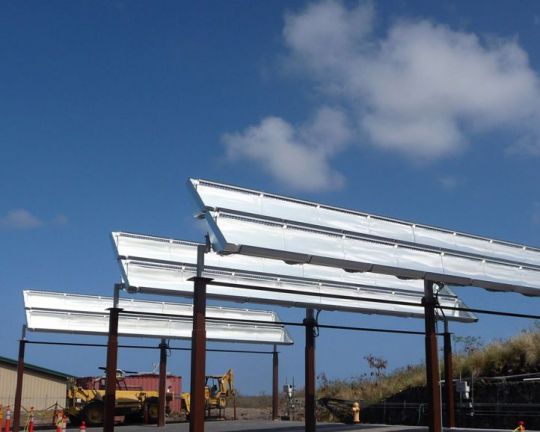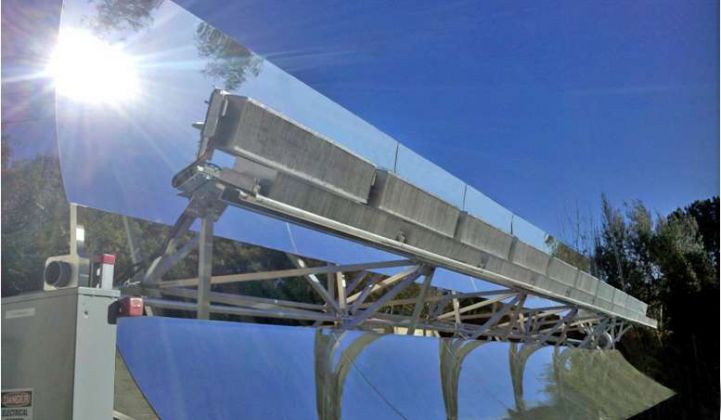In concentrating solar power, less is more -- or at least it is for Skyline Solar.
The Mountain View, Calif.-based company spent its first few years promoting a somewhat unusual concentrated photovoltaic (CPV) system that combined silicon solar cells and aluminum reflectors. To describe the technology in a nutshell, a W-shaped reflector concentrated sunlight onto rows of solar modules suspended in the air above them.
The key to the system was that aluminum is hardy and cheap. Sure, you wouldn’t want your dentist using aluminum mirrors while giving you a root canal, but for bouncing the sun’s rays, shiny metal works. Skyline’s panels came from an auto parts manufacturer in Mexico. It shipped them by stacking them into ordinary shipping containers. The system, again, also employed silicon solar cells, not exotic III-V components.
This year, Skyline has replaced the old system with the X14, which employs mirrors. The move to mirrors didn’t arise from a sudden bout of conformity. Reflectors, helped by growth in the solar thermal industry, had come down enough in price to justify the swap, says Tim Keating, vice president of marketing and field operations at Skyline.
More importantly, the switch let Skyline extensively retrofit the entire system in a way that dramatically reduced component count and installation cost while boosting performance. The new-and-improved X14 will deliver power, at least according to Skyline, for less than 10 cents per kilowatt-hour in sunny locales.
“We can get to $3.30 per watt in terms of capital costs,” Keating said, which is less than standard flat plate PV systems. “We got rid of half of the [solar] panels and doubled the concentration.”
A 500-kilowatt solar farm in Durango, Mexico will serve as one of the first large-scale test beds for the new systems. Other large deals are in the works in Rajasthan, North America and Qatar.
“Grid parity is here. It’s done,” he added.
While the new system will likely live or die by the field data in early trials, Skyline’s timing couldn’t be better, as concentrators -- once the proverbial zero-billion-dollar industry -- have begun to take flight.
San Diego Gas & Electric has signed contracts for 305 megawatts' worth of power from CPV systems from Soitec. (Soitec got the technology from Concentrix.) Southern California Edison, meanwhile, should see 29 megawatts' worth of CPV systems from Amonix come on-line in 2013 and 2014. SolFocus recently completed a 1-megawatt CPV field near Hanford, California and says it will ship 20 megawatts of components this year. Even SunPower will come out with a concentrator and expect to see hybrid systems that produce electricity and hot water via CPV.
New CPV installations are slated to grow from 5 megawatts in 2010 to 1 gigawatt by 2015, according to GTM Research.
In the overall market, Skyline is a small player -- but it's better to be a small player in a promising market than one that’s plummeting. The shift in CPV attitudes can be chalked up to improved technology, greater comfort among project developers and banks with the concept, the accumulation of more data, and the challenges some module makers have had in boosting the efficiency of silicon.
The most visible change is that the switch from aluminum to mirrors allowed Skyline to reduce the number of reflectors and solar panels by 50 percent. The old system consisted of a W-shaped reflector made from four rows of sheet aluminum. These reflectors bounced light onto solar modules placed above the outside legs and apex of the 'W.' Light from the outside reflectors would bounce to the central modules and vice versa. (See below.)
The X14 consists of a shallow V-shaped reflector made from two rows of mirrors. Those mirrors direct sunlight to solar modules placed between them. In the end, power production stays the same, but the bill of materials is roughly halved because concentration gets doubled. (See above.)
Additionally, Skyline approximately doubled the length of a reflector module from 5.6 meters to 11.6 meters. Fewer reflector arrays resulted in fewer gaps in the arrays and hence greater solar harvesting and power production.
Perhaps more importantly, doubling the length of the reflector module slashes the required in-field labor. Instead of installing 20 pre-built modules in a row, developers only have to install 10 to cover the same amount of real estate. By 2012, labor and other balance-of-system costs will likely surpass modules as the most expensive part of a solar installation.
The retrofit is in many ways similar to the one performed by Areva Solar when it purchased solar thermal technology from Ausra.

At the same time, Skyline managed to maintain some of the benefits of the early system. Because the solar modules effectively float in the air, they can be cooled with heat sinks and the air itself. The solar modules -- which are only a few inches long and contain only three solar cells -- can be swapped out as solar efficiencies improve or cells degrade. Thus, trackers and reflectors can potentially enjoy a longer functional life in the field.
“The panels literally just click on in less than ten seconds,” Keating said.
And, because the system uses silicon cells, the cost of the cells is lower and the need for pinpoint accuracy on the tracker is lessened. Skyline has around a 3-degree margin of error on tracking. Some high-level concentrators have to be within tenths of a percent.
The company’s upcoming projects will show whether or not this technology switch will work as envisioned, but it’s an interesting example of how innovation in solar is occurring beyond the traditional focus on cell and modules.



